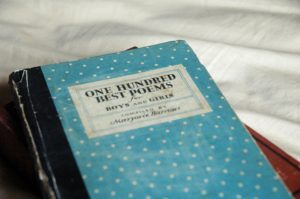
Learning Objectives
Students will analyze poetry relating to dogs and create their own dog poem utilizing poetic structure.
*Note: This is a multi-day lesson.
Grade Levels
6-8
Common Core English Language Arts Standards
CCSS.ELA-LITERACY.RL.7.4
Determine the meaning of words and phrases as they are used in a text, including figurative and connotative meanings; analyze the impact of rhymes and other repetitions of sounds (e.g., alliteration) on a specific verse or stanza of a poem or section of a story or drama.
CCSS.ELA-LITERACY.RL.7.5
Analyze how a drama’s or poem’s form or structure (e.g., soliloquy, sonnet) contributes to its meaning.
Materials Needed
Poetry Document: HERE
Highlighters (one per student)
Response Questions Document: HERE
Access to a computer or personal device with internet for research
Lesson
Prior to the Lesson
- This is not an introductory lesson. Review important poetry terms (stanza, verse, rhyme, repetition, alliteration, figurative and literal meanings, simile, imagery, metaphor, personification, theme, etc.) and types of poetry (free verse, sonnet, haiku, limerick, couplet, narrative, etc.) with the class prior to starting the lesson.
Introduction and Guided Instruction
- Hand out the Poems Document to students. Explain that they will be reading and analyzing poems about dogs.
- Read aloud the poem, “A Dog in San Francisco” by Michael Ondaatje. After reading the poem aloud, instruct students to reread the poem silently to themselves and highlight anything that they think is interesting or want to discuss further. Have students share what they highlighted and discuss.
- Ask students to share what they think the theme (or underlying message) of the poem might be (perhaps freedom, or to enjoy life and the little things, envy, etc.). Have them provide details explaining why they think that.
- Discuss how the author uses personification in this poem to relate the dog to a human and refer to specific lines/phrases such as: You leap into the air and pivot / a diver going up! and You are known to open the fridge and eat when you wish. Talk about why the author writes this way (the narrator yearns to have the freedom and skills that a dog has, a dog is confident, etc.).
- Discuss how the poem is different at the end then in the beginning. Why does the narrator want to be a dog by the end of the poem? Discuss how he compares himself to a dog.
- Read aloud the poem “Lost Dog” by Ellen Bass. After reading the poem aloud, instruct students to reread the poem silently to themselves and highlight anything that they think is interesting or want to discuss further. Have students share what they highlighted and discuss.
- Have students share what they think the theme (or underlying message) of the poem might be (having thanks and being grateful for the simple things in life like a dog). Have them provide details explaining why they think that.
- Discuss how the author creates imagery in the poem. Have students provide examples (fog drifting in / faint tinkling of tag against collar / black silhouette with tall ears rushing toward me through the wild radish / sprawls on the deep, red rug / resting on outstretched paws, etc.)
- Ask students to see if they can locate the metaphor in this poem (joy does another lap around the racetrack of my heart). Have students brainstorm what they think this means.
- Discuss and define any unknown or difficult words/phrases with students (fragrant with anise and mint / I’m suffused with contentment, etc.).
- Ask students what they think the last stanza of the poem means (If I could lose him like this every day I’d be the happiest woman alive). Talk about how the author is using figurative language and that she doesn’t really want to lose the dog but wants to be able to maintain her grateful mindset of him every day.
- Compare and contrast both poems. Talk about how both poems are free verse in nature.
Independent Group Work
- Place students in pairs of two. Ask that each group to read the remaining two poems, “Dogs Around the Block” and “Dharma,” and work together to answer response questions for each. Ensure each student pair has access to a computer or personal device for research.
- Circulate and assist students while they complete the activity.
Review and Closing
- Review both poems and student responses as a class when finished.
Lesson Extension
- Have students create their own free verse poem about a dog and share with the class.
References
Bass, Ellen. “Lost Dog.” 2007. Retrieved from https://bookriot.com/2019/01/17/best-dog-poems/.
Collins, Billy. “Dharma.” August 1998. Retrieved from https://bookriot.com/2019/01/17/best-dog-poems/.
Dog Breeds. (n.d.). Retrieved from https://www.akc.org/dog-breeds/.
Ondaatje, Michael. “A Dog in San Francisco.” 1992. Retrieved from https://bookriot.com/2019/01/17/best-dog-poems/.
White, E.B. “Dog Around the Block.” 1938. Retrieved from https://bookriot.com/2019/01/17/best-dog-poems/.

